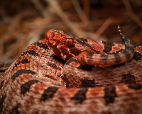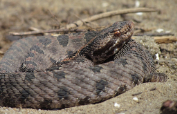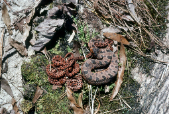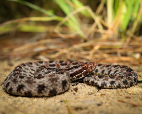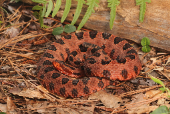Carolina Pygmy Rattlesnake (Sistrurus miliarius miliarius)
Description: he Carolina Pygmy Rattlesnake, often called the "Ground Rattler", is a heavy-bodied snake. The body of the snake is grey or reddish. A red or rust colored stripe often runs along the spine. The snake is marked by dark brown or black blotches along its spine that appear to cover the red stripe. There is also one or two rows of dark brown or black blotches on its sides. There is a dark cheek-stripe on both sides of the head that starts at the eye and runs diagonally down and backwards to the jaw above the mouthline. The bottom of the cheek-stripe is often edged in white. The top of the head is often marked by two stripes that continue on to the neck. The end of the tail has a small rattle on it that is seldom lounder than a buzzing insect, and is often not heard or even seen. This subspecies is notable for its red phase coloration, although slate-grey and dull-lavender specimens are not uncommon.
Habitat: It prefers upland habitats such as sand hills and longleaf pine savannas, and may occasionally be found in the foothills of South Carolina and Georgia, with rare populations moving through the mountains of Georgia into Alabama. However, recent reports have concluded that S. m. miliarius makes use of lowland environments such as hardwood bottomlands and Carolina bays.
Range: In the United States, the Carolina Pygmy Rattlesnake is found in Alabama, Georgia, North Carolina, and South Carolina.
Found in these States:
AL |
GA |
NC |
SC
Venom: Wright and Wright (1957) include excerpts from Allen (1938) that describe how an assistant was bitten by S. m. barbouri in the Everglades and suffered severe pain and swelling for about 24 hours despite treatment. Allen also quotes some statistics: according to the Florida Reptile Institute, 28 people were bitten by this subspecies in Florida between 1935 and 1937 with no deaths. Though these bites are painful, they are not considered life-threatening to people or pets.
The venom contain disintegrins, notably barbourin which has a KGD (Lys-Gly-Asp) amino acid motif rather than the more common RGD (Arg-Gly-Asp) motif. This single amino acid alteration gives barbourin higher binding affinity for the fibrinogen receptor glycoprotein IIb/IIIa. This receptor plays an important role in the aggregation of platelets, which then leads to the formation of a blood clot – competitive inhibition of this receptor by barbourin will decrease platelet aggregation, and thus reduce clotting.
Diet: prey includes small reptiles, amphibians, centipedes and small snakes.
Reproduction: Adult females of S. m. barbouri give birth to between 5 and 7 young at a time. In a brood of 8 from Silver Springs, Marion County, Florida, each neonate measured between 6.2 and 6.8 inches in total length.[4
Status: Listed as Least Concern in view of its wide distribution, presumed large population, and because it is unlikely to be declining fast enough to qualify for listing in a more threatened category.
»» Kingdom: Animalia - Animals
»» Phylum: Chordata - Chordates
»» Subphylum: Vertebrata - Vertebrates
»» Class: Reptilia - Reptiles
»» Order: Squamata - Scaled Reptiles
»» Suborder: Serpentes
»» Clade: Colubroides
»» Family: Viperidae - Vipers
»» Genus: Sistrurus
»» Species: Sistrurus miliarius - Pygmy Rattlesnake
»» Subspecies: Sistrurus miliarius miliarius - Carolina Pygmy Rattlesnake
This article uses material from the Wikipedia article "Sistrurus miliarius", which is released under the Creative Commons Attribution-Share-Alike License 3.0. Content may have been omitted from the original, but no content has been changed or extended.
|





